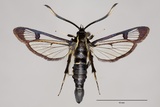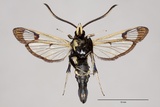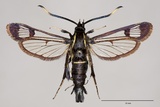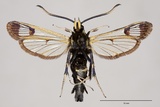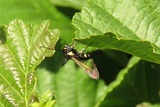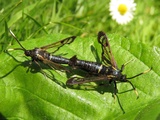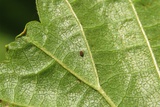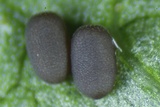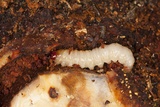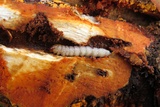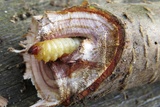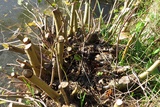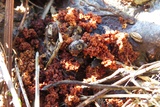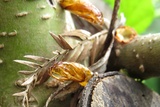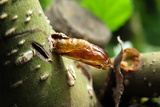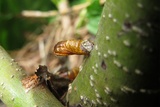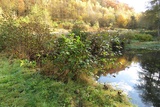Synanthedon spheciformis ([Denis & Schiffermüller], 1775) Species
Last modified: Nov. 21, 2025, 6:25 p.m.
This is a local species in Belgium, mainly in the Kempen and in the southern part of the country.
This species is considered Near Threatened according to the IUCN Red List category for Flanders 2023.
Details
- Classification
- Family: Sesiidae > Subfamily: Sesiinae > Tribus: Synanthedonini > Genus: Synanthedon > Species: Synanthedon spheciformis
- Vernacular names
- Elzenwespvlinder (NL), White-barred Clearwing (EN), Sésie de l'Aulne (FR), Erlen-Glasflügler (DE)
- First mention in Belgium
- De Sélys-Longchamps E. 1837. Catalogue des Lépidoptères ou Papillons de la Belgique, précédé du tableau des Libellulines de ce pays. — — : 1–29. On page 21 (as Sesia Spheciformis). view page
- Status
-
Native
Distribution
Imago
S. spheciformis is one of the larger clearwing species in Belgium (23–32 mm). It is easily recognisable by the almost completely black colouration and only one yellow band on the abdomen. Another striking feature is the pale yellow colouration of the distal part of the black antennae.
Males of this species are reasonably well attracted by the pheromone originally developed for S. tipuliformis.
Mine
The caterpillars construct galleries between wood and bark if they live in larger trees (often the remaining stump of a cut tree). If they live in smaller stems (the most common situation) a gallery, going downwards into the root-system, is constructed in the centre of the stem.
Cocoon/pupa
This species does not construct a cocoon, so the pupa can move freely up and down in the gallery.
Bionomics
The female lays the eggs on the underside of leaves of the foodplants. The young larva works its way towards the base of the stem and lives on the sap flow between wood and bark. After the first wintering, the larvae start to make mines in the wood as well, and also construct a gallery in the central part of a stem.
Before the second hibernation the caterpillar enlarges that shaft and, at the end of it, bends it outwards towards the bark to construct the future exit hole, leaving just a thin layer of bark.
In Alnus, which has a smooth and thin bark, this "membrane" discolours reddish to brown or even almost black. When living in Betula, with a more rough bark, the future exit hole is invisible from the outside.
Next springtime, the larva pupates without constructing a cocoon. The pupa is very mobile in its gallery, giving it the ability to respond to weather conditions or external disturbances. When hatching, which mostly takes place in late morning, the pupa breaks through the bark membrane and slides out halfway. The exit hole is always quite low in the stem and is rarely found higher than 25 cm above ground level.
Flight periods
The adults fly between mid-May and the end of June.
Observed on
- Host plant (species):
- Alnus glutinosa, Alnus incana, Betula pubescens and Betula pendula
The larva mainly bores into the stem and root of Alnus but Betula is also often used as hostplant.
Habitat
The preferred habitats are moist and even marshy places where the main hostplant Alnus is common. In drier areas, (young) Betula trees are occupied as well as Alnus. This is often the case in heath landscapes where there are often a lot of young Betula trees together with young Alnus trees in the vicinity of fens.
In managed areas S. spheciformis can be really abundant in the new shoots formed by regularly cut Alnus trees at the borders of fish ponds.
